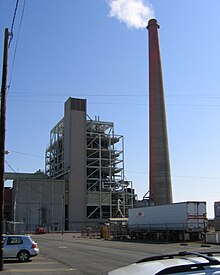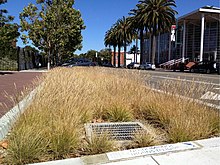Thermal pollution

The Brayton Point Power Station in Massachusetts discharged heated water to Mount Hope Bay.[1] The plant was shut down in June 2017.[2]
Thermal pollution is the degradation of water quality by any process that changes ambient water temperature. A common cause of thermal pollution is the use of water as a coolant by power plants and industrial manufacturers. When water used as a coolant is returned to the natural environment at a higher temperature, the sudden change in temperature decreases oxygen supply and affects ecosystem composition. Fish and other organisms adapted to particular temperature range can be killed by an abrupt change in water temperature (either a rapid increase or decrease) known as "Thermal shock."
Urban runoff—stormwater discharged to surface waters from roads and parking lots—can also be a source of elevated water temperatures.
Contents
1 Ecological effects
1.1 Warm water
1.2 Cold water
1.3 Thermal shock
2 Sources and control of thermal pollution
2.1 Industrial wastewater
2.2 Urban runoff
3 See also
4 References
Ecological effects

Potrero Generating Station discharged heated water into San Francisco Bay.[3] The plant was closed in 2011.[4]
Warm water
Elevated temperature typically decreases the level of dissolved oxygen of water, as gases are less soluble in hotter liquids. This can harm aquatic animals such as fish, amphibians and other aquatic organisms. Thermal pollution may also increase the metabolic rate of aquatic animals, as enzyme activity, resulting in these organisms consuming more food in a shorter time than if their environment were not changed.[5]:179 An increased metabolic rate may result in fewer resources; the more adapted organisms moving in may have an advantage over organisms that are not used to the warmer temperature. As a result, food chains of the old and new environments may be compromised. Some fish species will avoid stream segments or coastal areas adjacent to a thermal discharge. Biodiversity can be decreased as a result.[6]:415–17[7]:340
High temperature limits oxygen dispersion into deeper waters, contributing to anaerobic conditions. This can lead to increased bacteria levels when there is ample food supply. Many aquatic species will fail to reproduce at elevated temperatures.[5]:179–80
Primary producers (e.g. plants, cyanobacteria) are affected by warm water because higher water temperature increases plant growth rates, resulting in a shorter lifespan and species overpopulation. This can cause an algae bloom which reduces oxygen levels.
Temperature changes of even one to two degrees Celsius can cause significant changes in organism metabolism and other adverse cellular biology effects. Principal adverse changes can include rendering cell walls less permeable to necessary osmosis, coagulation of cell proteins, and alteration of enzyme metabolism. These cellular level effects can adversely affect mortality and reproduction.
A large increase in temperature can lead to the denaturing of life-supporting enzymes by breaking down hydrogen- and disulphide bonds within the quaternary structure of the enzymes. Decreased enzyme activity in aquatic organisms can cause problems such as the inability to break down lipids, which leads to malnutrition.
In limited cases, warm water has little deleterious effect and may even lead to improved function of the receiving aquatic ecosystem. This phenomenon is seen especially in seasonal waters and is known as thermal enrichment. An extreme case is derived from the aggregational habits of the manatee, which often uses power plant discharge sites during winter. Projections suggest that manatee populations would decline upon the removal of these discharges.
Cold water
Releases of unnaturally cold water from reservoirs can dramatically change the fish and macroinvertebrate fauna of rivers, and reduce river productivity. In Australia, where many rivers have warmer temperature regimes, native fish species have been eliminated, and macroinvertebrate fauna have been drastically altered. This may be mitigated by designing the dam to release warmer surface waters instead of the colder water at the bottom of the reservoir.[8]
Thermal shock
When a power plant first opens or shuts down for repair or other causes, fish and other organisms adapted to particular temperature range can be killed by the abrupt change in water temperature, either an increase or decrease, known as "thermal shock".[7]:208[9]:478
Sources and control of thermal pollution

Cooling tower at Gustav Knepper Power Station, Dortmund, Germany
Industrial wastewater
In the United States, about 75 to 82 percent of thermal pollution is generated by power plants.[7]:335 The remainder is from industrial sources such as petroleum refineries, pulp and paper mills, chemical plants, steel mills and smelters.[10][11] Heated water from these sources may be controlled with:
Cooling ponds, man-made bodies of water designed for cooling by evaporation, convection, and radiation
cooling towers, which transfer waste heat to the atmosphere through evaporation and/or heat transfer
cogeneration, a process where waste heat is recycled for domestic and/or industrial heating purposes.[12]
Some facilities use once-through cooling (OTC) systems which do not reduce temperature as effectively as the above systems. For example, the Potrero Generating Station in San Francisco (closed in 2011), used OTC and discharged water to San Francisco Bay approximately 10 °C (20 °F) above the ambient bay temperature.[13]

A bioretention cell for treating urban runoff in California
Urban runoff
During warm weather, urban runoff can have significant thermal impacts on small streams, as storm water passes over hot parking lots, roads and sidewalks. Storm water management facilities that absorb runoff or direct it into groundwater, such as bioretention systems and infiltration basins, can reduce these thermal effects. These and related systems for managing runoff are components of an expanding urban design approach commonly called green infrastructure.[14]
Retention basins (stormwater ponds) tend to be less effective at reducing runoff temperature, as the water may be heated by the sun before being discharged to a receiving stream.[15]
See also
|
- Water cooling
- Water pollution
- Water quality
References
^ "Brayton Point Station: Final NPDES Permit". NPDES Permits in New England. U.S. Environmental Protection Agency (EPA), Boston, MA. 2014. Retrieved 2015-04-13..mw-parser-output cite.citation{font-style:inherit}.mw-parser-output .citation q{quotes:"""""""'""'"}.mw-parser-output .citation .cs1-lock-free a{background:url("//upload.wikimedia.org/wikipedia/commons/thumb/6/65/Lock-green.svg/9px-Lock-green.svg.png")no-repeat;background-position:right .1em center}.mw-parser-output .citation .cs1-lock-limited a,.mw-parser-output .citation .cs1-lock-registration a{background:url("//upload.wikimedia.org/wikipedia/commons/thumb/d/d6/Lock-gray-alt-2.svg/9px-Lock-gray-alt-2.svg.png")no-repeat;background-position:right .1em center}.mw-parser-output .citation .cs1-lock-subscription a{background:url("//upload.wikimedia.org/wikipedia/commons/thumb/a/aa/Lock-red-alt-2.svg/9px-Lock-red-alt-2.svg.png")no-repeat;background-position:right .1em center}.mw-parser-output .cs1-subscription,.mw-parser-output .cs1-registration{color:#555}.mw-parser-output .cs1-subscription span,.mw-parser-output .cs1-registration span{border-bottom:1px dotted;cursor:help}.mw-parser-output .cs1-ws-icon a{background:url("//upload.wikimedia.org/wikipedia/commons/thumb/4/4c/Wikisource-logo.svg/12px-Wikisource-logo.svg.png")no-repeat;background-position:right .1em center}.mw-parser-output code.cs1-code{color:inherit;background:inherit;border:inherit;padding:inherit}.mw-parser-output .cs1-hidden-error{display:none;font-size:100%}.mw-parser-output .cs1-visible-error{font-size:100%}.mw-parser-output .cs1-maint{display:none;color:#33aa33;margin-left:0.3em}.mw-parser-output .cs1-subscription,.mw-parser-output .cs1-registration,.mw-parser-output .cs1-format{font-size:95%}.mw-parser-output .cs1-kern-left,.mw-parser-output .cs1-kern-wl-left{padding-left:0.2em}.mw-parser-output .cs1-kern-right,.mw-parser-output .cs1-kern-wl-right{padding-right:0.2em}
^ Finucane, Martin (2017-06-01). "Mass. says goodbye to coal power generation". Boston Globe.
^ Selna, Robert (2009). "Power plant has no plans to stop killing fish." San Francisco Chronicle, January 2, 2009.
^ Pacific Gas & Electric Co. "Potrero Power Plant: Site Overview." Accessed 2012-07-17.
^ ab Goel, P.K. (2006). Water Pollution - Causes, Effects and Control. New Delhi: New Age International. ISBN 978-81-224-1839-2.
^ Kennish, Michael J. (1992). Ecology of Estuaries: Anthropogenic Effects. Marine Science Series. Boca Raton, Florida: CRC Press. ISBN 978-0-8493-8041-9.
^ abc Laws, Edward A. (2000). Aquatic Pollution: An Introductory Text. New York: John Wiley and Sons. ISBN 978-0-471-34875-7.
^ Mollyo, Fran (15 September 2015). "A happier environment for fish". Phys.org. Retrieved 15 September 2015.
^ Chiras, Daniel D. (2012). Environmental Science. Burlington, MA: Jones & Bartlett. ISBN 9781449614867.
^ EPA, Washington, D.C. (May 2014). "Technical Development Document for the Final Section 316(b) Existing Facilities Rule." Document No. EPA 821-R-14-002. p 4-2.
^ EPA (June 2006). "Technical Development Document for the Final Section 316(b) Phase III Rule." Document No. EPA 821-R-06-003. Chapter 2.
^ EPA (1997). "Profile of the Fossil Fuel Electric Power Generation Industry" (PDF). Office of Compliance, Sector Notebook Project. p. 24. Archived from the original on 2011-02-03. Document No. EPA/310-R-97-007.
^ California Environmental Protection Agency. San Francisco Bay Regional Water Quality Control Board. "Waste Discharge Requirements for Mirant Potrero, LLC, Potrero Power Plant." Archived 2011-06-16 at the Wayback Machine Order No. R2-2006-0032; NPDES Permit No. CA0005657. May 10, 2006.
^ "What is Green Infrastructure?". EPA. 2015-11-02.
^ EPA (August 1999). "Preliminary Data Summary of Urban Storm Water Best Management Practices." Document No. EPA-821-R-99-012. p. 5-58.
.mw-parser-output .refbegin{font-size:90%;margin-bottom:0.5em}.mw-parser-output .refbegin-hanging-indents>ul{list-style-type:none;margin-left:0}.mw-parser-output .refbegin-hanging-indents>ul>li,.mw-parser-output .refbegin-hanging-indents>dl>dd{margin-left:0;padding-left:3.2em;text-indent:-3.2em;list-style:none}.mw-parser-output .refbegin-100{font-size:100%}
Langford, Terry E.L. (1990). Ecological effects of thermal discharges. Pollution Monitoring Series. London: Elsevier Applied Science. ISBN 1-85166-451-3.
Hogan, Michael; Patmore, Leda C.; Seidman, Harry (August 1973). Statistical Prediction of Dynamic Thermal Equilibrium Temperatures using Standard Meteorological Data Bases. Washington, D.C.: EPA. EPA-660/2-73-003.
Thackston, E.L.; Parker, F.L. (March 1971). Effect of Geographical Location on Cooling Pond Requirements. Water Pollution Control Research Series. Washington, D.C.: EPA. EPA-830-R-71-001.
Edinger, J.E.; Geyer, J.C (1965). "Heat Exchange in the Environment". New York: Edison Electric Institute.

